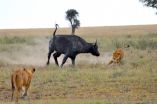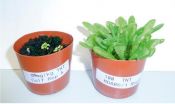Beyond species counts: Using evolutionary history to inform conservation
Recent study investigates multiple phylogenetic diversity metrics and discusses their role in preserving biodiversity
2015-09-03
(Press-News.org) Earth's species are disappearing at an astonishing--and troubling--rate. As human activity continues to put pressure on ecosystems around the world, the rate of loss continues to climb. How we slow this devastating loss and protect the enormous number of species on Earth is of considerable importance, and debate.
Unfortunately, it is not feasible to simply protect everything. Limited funds require conservation planners and policy makers to prioritize the preservation of specific regions and ecosystems. An often-used strategy is to identify areas of high species richness and high endemicity--a region containing a high proportion of species that are found nowhere else in the world--in order to set conservation priorities.
This, and other long-used approaches, have a major shortcoming, though: they ignore evolutionary history.
"By not considering diversity resulting from evolutionary history, current biodiversity assessments may be overlooking unique and important regions for conservation," explains Dr. Roxanne Kellar, lead author of a recent study aimed at testing different assessment tools and biodiversity metrics. The study--a collaboration between scientists at the University of Nebraska and the University of Missouri--is freely available in a recent issue of Applications in Plant Sciences.
Despite strong arguments to incorporate evolutionary history into conservation strategies, phylogenetic diversity metrics have not been widely adopted by conservation planners. "The goal of our research is to provide empirical tests of the many tools available to ecologists and conservation planners and to provide potential users the means to decide which metrics are most useful in their particular situation," says Kellar.
Kellar and colleagues tested a dozen commonly used phylogenetic diversity metrics, focusing on two large flowering plant families found in prairie ecosystems: the sunflower and pea families. Their results highlight the differences between biodiversity metrics and the difficulties of obtaining sufficient data to accurately calculate these metrics.
The most challenging aspect of calculating phylogenetic diversity metrics is the acquisition of a phylogeny, or evolutionary tree, for the area of interest. Researchers must sample a large percentage of the species present in the area under investigation and obtain the same set of genes for each of these species.
"There is a misconception about the availability of data in online sequence repositories such as GenBank," says Kellar. "Although this is an enormous, and important, resource for genetic data, it is often insufficient for accurately calculating biodiversity metrics, leaving researchers to generate this data themselves."
However, once a phylogeny is obtained, it is fairly simple to calculate all of the metrics. Kellar and colleagues are optimistic, "As more sequence data are generated from high-throughput sequencing and more phylogenies are published across the tree of life, calculating multiple, reliable biodiversity metrics will become increasingly routine."
INFORMATION:
P. Roxanne (Steele) Kellar, Dakota L. Ahrendsen, Shelly K. Aust, Amanda R. Jones, and J. Chris Pires. 2015. Biodiversity comparison among phylogenetic diversity metrics and between three North American prairies. Applications in Plant Sciences 3(7): 1400108. doi:10.3732/apps.1400108
Applications in Plant Sciences (APPS) is a monthly, peer-reviewed, open access journal focusing on new tools, technologies, and protocols in all areas of the plant sciences. It is published by the Botanical Society of America, a nonprofit membership society with a mission to promote botany, the field of basic science dealing with the study and inquiry into the form, function, development, diversity, reproduction, evolution, and uses of plants and their interactions within the biosphere. APPS is available as part of BioOne's Open Access collection.
For further information, please contact the APPS staff at apps@botany.org.
ELSE PRESS RELEASES FROM THIS DATE:
2015-09-03
September 3, 2015 - Men and women exposed in early gestation to the man-made Ukrainian Famine of 1932-33 in regions with extreme food shortages were 1.5 times more likely to be diagnosed with Type 2 diabetes in adulthood. In regions with severe famine there was a 1.3 fold rise in the odds of Type 2 diabetes, and there was no diabetes increase among individuals born in regions with no famine.
Researchers at Columbia University's Mailman School of Public Health, the Komisarenko Institute of Endocrinology and Metabolism in Kiev, Ukraine, and the Cheboratev Institute of Gerontology ...
2015-09-03
MADISON, Wis. -- "Gaydar" -- the purported ability to infer whether people are gay or straight based on their appearance -- seemed to get a scientific boost from a 2008 study that concluded people could accurately guess someone's sexual orientation based on photographs of their faces.
In a new paper published in the Journal of Sex Research, researchers at the University of Wisconsin-Madison challenge what they call "the gaydar myth." William Cox, an assistant scientist in the Department of Psychology and the lead author, says gaydar isn't accurate and is actually a harmful ...
2015-09-03
The gut is an important reservoir for drug-resistant bacteria responsible for life-threatening hospital-acquired infections. A study in mice published on September 3rd in PLOS Pathogens reports that two of the most common antibiotic-resistant bacterial species circulating in hospitals occupy and effectively share the same location in the gut, and that they can be eliminated by fecal transplantation of a healthy gut microbiome.
Eric Pamer, from Memorial Sloan-Kettering Cancer Center in New York, USA, and colleagues, investigated the interactions between vancomycin-resistant ...
2015-09-03
Much like birds fly in flocks to conserve energy, dolphins swim in pods to mate and find food, and colonies of ants create complex nests to protect their queens, immune cells engage in coordinated behavior to wipe out viruses like the flu. That's according to a new study published today in the journal Science by researchers at the University of Rochester School of Medicine and Dentistry.
The findings reveal, for the first time, how immune cells work together to get to their final destination - the site of an injury or infection. The body is expansive and a virus or bacteria ...
2015-09-03
WASHINGTON, DC (September 3, 2015)-- The District of Columbia's needle exchange program prevented 120 new cases of HIV infection and saved an estimated $44 million over just a two-year period, according to a first-of-a-kind study published today by researchers at the Milken Institute School of Public Health (Milken Institute SPH) at the George Washington University.
"Our study adds to the evidence that needle exchange programs not only work but are cost-effective investments in the battle against HIV," says Monica S. Ruiz, PhD, MPH, an assistant research professor in ...
2015-09-03
Why are there not more lions when there's plenty of prey on the African savanna?
A research team including two University of Guelph ecologists has discovered an unexpected pattern linking prey and predator species in diverse ecosystems worldwide.
Integrative biology professors John Fryxell and Kevin McCann co-authored the paper, published today in Science. The team included researchers at McGill University, the University of British Columbia and the Perimeter Institute for Theoretical Physics in Waterloo, Ont.
Beyond lions and the gazelles they hunt on the African ...
2015-09-03
This news release is available in Japanese.
Regular exposure to bacteria particles and farm dust protects children from allergies because it blunts their inflammatory immune responses, a new mouse study suggests. The study implicates a particular anti-inflammatory enzyme, A20, in this protective effect. While aspects of how allergies develop remain unclear, scientists know they're driven not only by genes but also by environment. Homes with pets, as well as dairy farms - where children breathe dust containing higher doses of fungal particles, cowshed-derived bacteria ...
2015-09-03
This news release is available in Japanese.
Ecological communities around the world are richly varied, but a new study finds that many of these diverse communities follow an unexpected, yet consistent pattern: where prey are abundant, there are not proportionally more predators. Instead, as prey biomass increases, the ratio of predator-to-prey biomass decreases. This pattern was systematically identified across different areas, including grasslands, forests, lakes, and oceans, revealing an underlying structural organization of ecosystems. Pinpointing underlying ...
2015-09-03
This news release is available in Japanese.
Researchers have identified a mutation in plants that allows them to break down TNT, an explosive that has become highly prevalent in soil in the last century, particularly at manufacturing waste sites, mines, and military conflict zones. TNT, or 2,4,6-trinitrotoluene, is a toxic and persistent environmental pollutant that accumulates in the roots of plants, inhibiting growth and development. The identification of a plant mechanism that not only evades the negative impacts of TNT, but breaks down this harmful substance could ...
2015-09-03
This news release is available in Japanese.
A special news edition, Science in Iran, looks closely at the scientific challenges and triumphs of a country that has faced international isolation in recent years. Following an exclusive interview about the Iran nuclear deal with Ali Akbar Salehi, president of the Atomic Energy Organization of Iran, Science International News Editor Richard Stone delves further into the state of Iran's scientific endeavors. Decades of economic sanctions have deprived Iranian scientists of critical scientific resources and collaboration. ...
LAST 30 PRESS RELEASES:
[Press-News.org] Beyond species counts: Using evolutionary history to inform conservation
Recent study investigates multiple phylogenetic diversity metrics and discusses their role in preserving biodiversity




